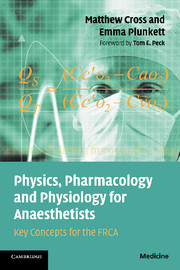Book contents
- Frontmatter
- Contents
- Acknowledgements
- Preface
- Foreword
- Introduction
- Section 1 Mathematical principles
- Section 2 Physical principles
- Simple mechanics
- The gas laws
- Laminar flow
- Turbulent flow
- Bernoulli, Venturi and Coanda
- Heat and temperature
- Humidity
- Latent heat
- Isotherms
- Solubility and diffusion
- Osmosis and colligative properties
- Resistors and resistance
- Capacitors and capacitance
- Inductors and inductance
- Defibrillators
- Resonance and damping
- Pulse oximetry
- Capnography
- Absorption of carbon dioxide
- Cardiac output measurement
- The Doppler effect
- Neuromuscular blockade monitoring
- Surgical diathermy
- Cleaning, disinfection and sterilization
- Section 3 Pharmacological principles
- Section 4 Pharmacodynamics
- Section 5 Pharmacokinetics
- Section 6 Respiratory physiology
- Section 7 Cardiovascular physiology
- Section 8 Renal physiology
- Section 9 Neurophysiology
- Section 10 Statistical principles
- Appendix
- Index
Bernoulli, Venturi and Coanda
Published online by Cambridge University Press: 15 January 2010
- Frontmatter
- Contents
- Acknowledgements
- Preface
- Foreword
- Introduction
- Section 1 Mathematical principles
- Section 2 Physical principles
- Simple mechanics
- The gas laws
- Laminar flow
- Turbulent flow
- Bernoulli, Venturi and Coanda
- Heat and temperature
- Humidity
- Latent heat
- Isotherms
- Solubility and diffusion
- Osmosis and colligative properties
- Resistors and resistance
- Capacitors and capacitance
- Inductors and inductance
- Defibrillators
- Resonance and damping
- Pulse oximetry
- Capnography
- Absorption of carbon dioxide
- Cardiac output measurement
- The Doppler effect
- Neuromuscular blockade monitoring
- Surgical diathermy
- Cleaning, disinfection and sterilization
- Section 3 Pharmacological principles
- Section 4 Pharmacodynamics
- Section 5 Pharmacokinetics
- Section 6 Respiratory physiology
- Section 7 Cardiovascular physiology
- Section 8 Renal physiology
- Section 9 Neurophysiology
- Section 10 Statistical principles
- Appendix
- Index
Summary
The Bernoulli principle
An increase in the flow velocity of an ideal fluid will be accompanied by a simultaneous reduction in its pressure.
The Venturi effect
The effect by which the introduction of a constriction to fluid flow within a tube causes the velocity of the fluid to increase and, therefore, the pressure of the fluid to fall.
These definitions are both based on the law of conservation of energy (also known as the ‘first law of thermodynamics’).
The law of conservation of energy
Energy cannot be created or destroyed but can only change from one form to another.
Put simply, this means that the total energy contained within the fluid system must always be constant. Therefore, as the kinetic energy (velocity) of the fluid increases, the potential energy (pressure) must reduce by an equal amount in order to ensure that the total energy content remains the same.
The increase in velocity seen as part of the Venturi effect simply demonstrates that a given number of fluid particles have to move faster through a narrower section of tube in order to keep the total flow the same. This means an increase in velocity and, as predicted, a reduction in pressure. The resultant drop in pressure can be used to entrain gases or liquids, which allows for applications such as nebulizers and Venturi masks.
The Coanda effect
The tendency of a stream of fluid flowing in proximity to a convex surface to follow the line of the surface rather than its original course.
- Type
- Chapter
- Information
- Physics, Pharmacology and Physiology for AnaesthetistsKey Concepts for the FRCA, pp. 28 - 29Publisher: Cambridge University PressPrint publication year: 2008



